Musk Ox are mostly found in the Tundra regions of the Arctic. One can find multiple of them distributed from Greenland to North America. These include northern Europe, Asia, Greenland, Alaska (U.S.), and Norway.
Previously, around 1850, Musk Ox got extinct in Alaska due to overhunting and unfavorable climatic conditions. However, later they were reintroduced in Alaska, and today, they are considered a vital part of the Alaskan lifestyle.
Musk Ox prefers to live in cold areas since it has successfully adapted to survive the climate. Therefore, they are known as the SHAGGY SURVIVORS OF THE ICE AGE.
Now, without any further ado, let’s buckle down through the article and learn more about the habitat of Musk Ox.
Where Does Musk Ox Live?
Musk Ox primarily inhabits the Northern areas of Russia, Alaska, and Europe. They prefer to live in the colder regions of ample hills and Tundra above the tree line.
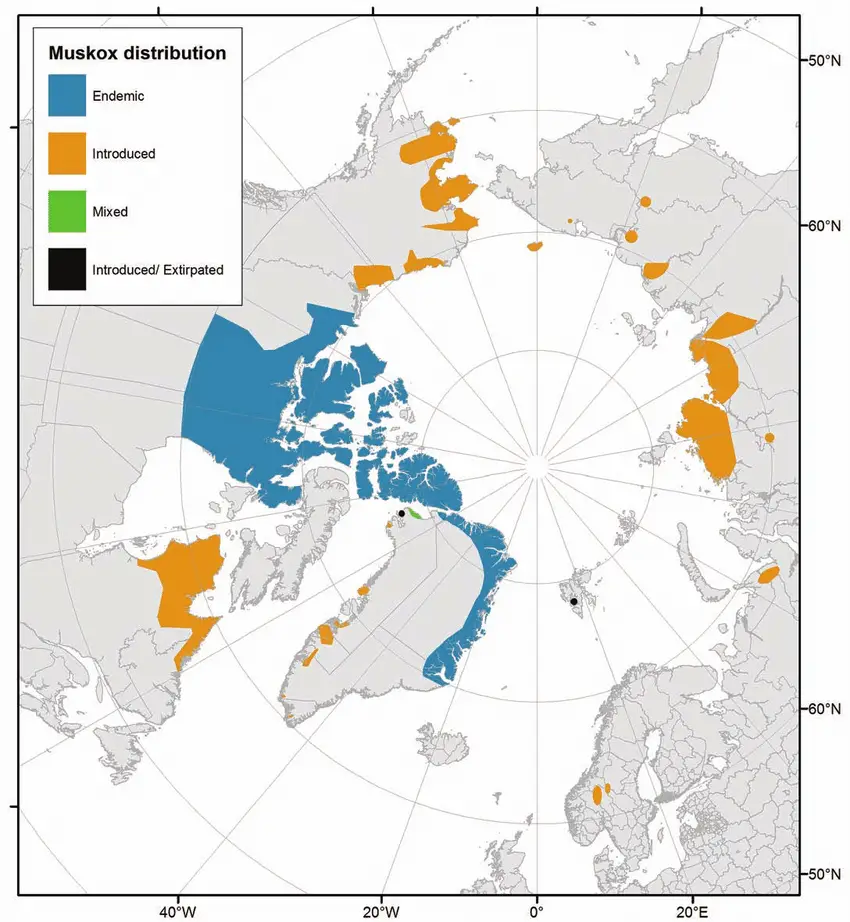
The reason is that Musk Ox has not adapted themselves to live in green forest areas.
Similarly, they don’t reside in snowy areas as they aren’t skilled and trained to search for food deep in the dense snow. In short, these long-beard animals roam in various locations of the Arctic.
Where does Musk Oxen live in Canada?
Lots of Musk Ox are found in Canada. You will be surprised to learn that only Canada and Greenland contain the naturally occurring Musk Ox. All other regions have introduced species now.
The temperature in China gets as cold as -53°C, and Musk Ox are adapted to bear temperatures up to -40°C to -60°C. Therefore, they don’t have any issues living there.
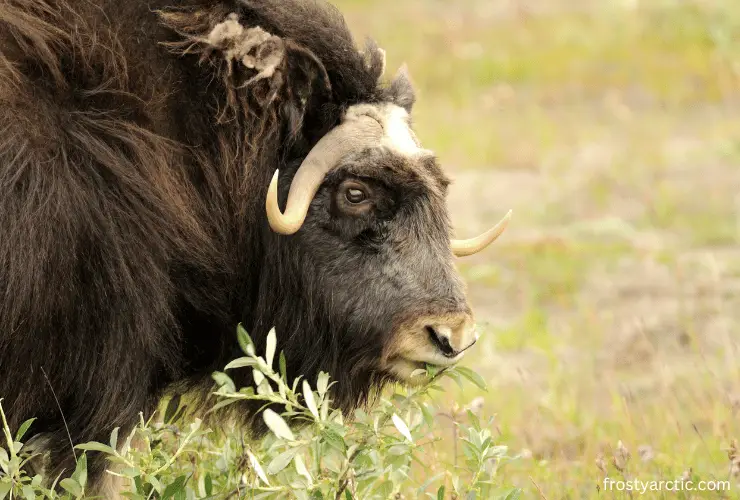
More than 85 thousand Musk Ox live in areas of Canada like Victoria Island, Bank island, North of Great Bear Lake, Queen Maud Gulf, Nunavut, and northeastern Keewatin.
Moreover, some Musk Oxen introduced from Alaska are found in Yukon and Svalbard.
Where do Musk Oxen live in Norway and Siberia?
Dovrefjell National Park is one of the best places in Norway to find Musk Ox. However, you can find some along the stream and in the mountainous region of Dovre.
Also Read: Bison vs Musk Ox: Key Differences Explained with Photos
Unfortunately, Musk Oxen were known to become extinct in Norway in 1932 and were reintroduced from Canada’s Bank Island. An attempt was made to introduce Musk Ox in Svalbard, too. However, it failed.
Similarly, more than 11,000 Musk Ox exist in different regions of Siberia, including Wrangel Island, the Chukotka Peninsula, the Taimyr Peninsula, and the Yamal Peninsula.
Where do Musk Oxen live in Greenland?
Musk Ox are native to Greenland, and you can find herds of them moving together, particularly in Greenland’s northern and western areas.
The trophy score for finding Musk Oxen in Greenland is more than Canada’s. The reason lies in the better living conditions, like grazing, compared to China’s.
Some of the famous areas to spot Musk Ox in Greenland are:
- Kangerlussuaq
- Disko Bay area
- Northeast Greenland National Park
- Sisimiut
- Uummannaq
- Qaanaaq
- Narsaq
- Ilulissat
- Qaqortoq
Where can you find Musk Oxen in Russia?
Musk Ox is not native to Russia. Instead, they were introduced to Russia in the early 20th century for conservation purposes.
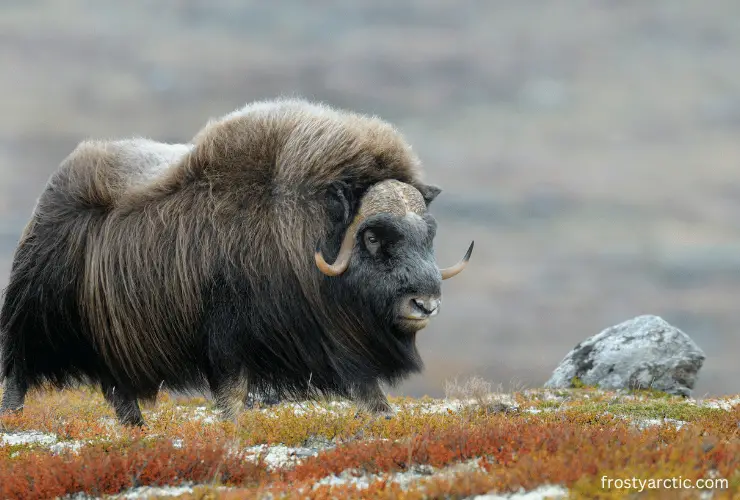
The reason why Russia was chosen is its optimal climatic conditions. It has long, cold winters and short, cool summers, just like the climate of the Arctic Tundra. So, Musk Ox thrived better in such conditions.
Musk Oxen are found in the following regions of Russia:
- Kolyma River Basin
- Anadyr Lowland
- New Siberian Islands
- Wrangel Island Nature Reserve
- Kamchatka Peninsula
- Yakutia
- Nenetsia Autonomous Okrug
- Vodlozero National Park
If you want to visit Russia to find Musk Ox, planning one in the summer is better.
Where does Musk Oxen live in Sweden?
Although the climate in Sweden is harsher than that of the Arctic tundra, Musk Ox have successfully adapted to it. You can find multiple of them in Sweden’s wildlife reserves and national parks.
Some of them are:
- Padjelanta National Park in Lapland
- Fulufjallet National Park
- Stora Sjofallet National Park
- Tiveden National Park
- Abisko National Park
- Raaidna Nature Reserve
- Stora Tuna Nature Reserve
Where can you find Musk Oxen in Alaska?
Musk Ox is native to Alaska. However, you can spot them throughout Alaska, particularly in northern and western Alaska.
Actually, Alaska offers the ideal climate and feeding conditions for Musk Oxens (temperature drops to -40°C and has lichens and mosses to feed on).
So, one can find Musk Ox in areas like:
- The northern slope of the Brooks Range
- Seward Peninsula
- Gates of the Arctic National Park and Preserve
- Alaska Wildlife Conservation Center in Portage
- Musk Ox Farm in Palmer
- Noatak National Preserve
- Arctic National Wildlife Refuge
- Bering Land Bridge National Preserve
- Wrangell-St. Elias National Park and Preserve
- Chugach State Park, and
- Kobuk Valley National Park.
Where was the first Musk Ox found?
The first Musk Oxen is recorded to be found in 1619 in Canada, near Hudson Bay, by Danish explorer Jens Munk.
However, the fossil records claim Ovibos moschatus to be the first Musk Ox on the face of the earth. It evolved from bovid during the Pleistocene epoch, nearly 11,700 years ago.
How Do Musk Oxen Survive the Harsh Conditions Of The Arctic? The Adaptations
Although the extreme climatic conditions of Arctic Tundra are quite difficult for most animals to live in, Musk Ox has successfully made various adaptations to survive and adapt to the harsh conditions. These include:
Double layer of coat
Musk Oxen have a double coat layer to protect them against cold weather and give extra insulation.
The inner coat, called qiviut, is composed of one of the finest wool. It is known to provide ultimate insulation and protection against harsh climates.
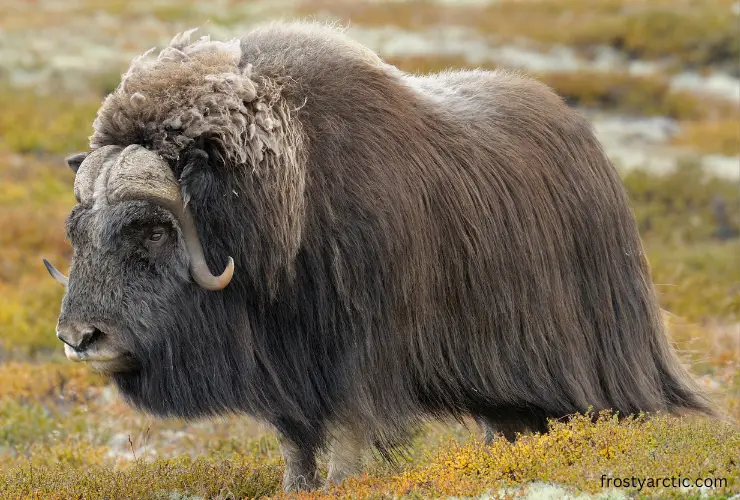
On the other hand, the outer coat is composed of long shaggy hairs called guard hairs. These hairs trap the cold air close to the skin and keep them warm. Secondly, these hairs deflect the wind, thus helping maintain body temperature.
Short legs and furry ears
Musk Oxen have short legs and furry ears. These contribute to a low surface area-to-volume ratio.
As a result, less heat is lost from the body, and more is conserved, thus leading to a maintained body temperature.
Hooves
In addition to short legs and furry ears, Musk Oxen have hooves. Hooves are composed of keratin and are considered a dead part.
Musk Ox use them to plow through the snow and fund food. Moreover, its concave shape helps them attain stability.
Hooves also contain some blood vessels that constrict in cold temperatures and prevent heat loss, thus contributing to thermoregulation.
Apart from these major adaptations, various other things like fat storage, herding, calving, strong sense, etc., help them easily thrive in the harsh arctic environment.
Can Musk Ox Live in Hot Sunny Areas?
No!
Musk Ox have well adapted their bodies to live in cold areas like Arctic Tundra, Canada, etc.
So they can only live in hot sunny areas for a short time.
And if exposed, they spend the entire time in wet areas like valleys or move to higher elevations to avoid hotness.
Do Musk Oxen Live in Water?
Musk Ox can be found on land and water, depending on the external environment, climate, and season.
Musk Ox prefer to roam about during winter as their anatomical structures are well adapted to the environment.
However, they use their hooves to plow the snow in extremely cold temperatures.
Similarly, they prefer to live in wet areas and rivers to maintain their temperature in high temperatures.
They simply cannot survive in warm climates.
Why Is Musk Ox Not Native to Antarctica?
Musk Ox are not native to Antarctica, nor can they be reinforced there. The reason is its extremely cold temperature.
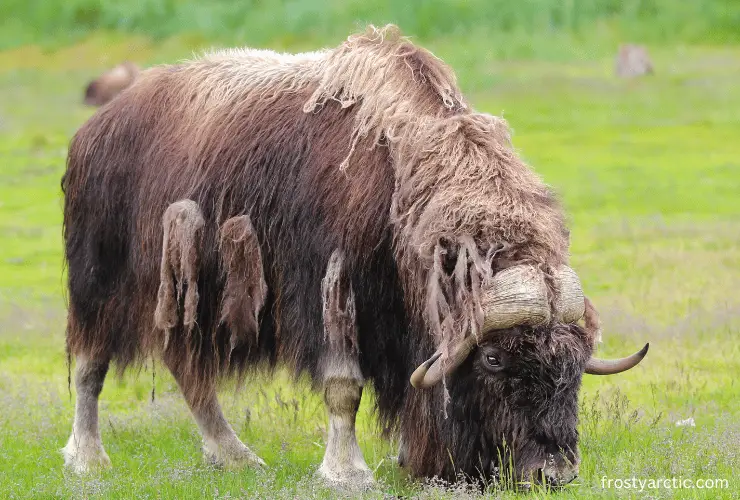
Yes! Musk Ox can survive temperatures as low as minus 40 to 50 degrees Celsius.
However, in Antarctica, the temperature falls as low as -90°C, in which a Musk Ox fails to survive.
Therefore, they aren’t found in Antarctica.
How Long Does a Musk Ox Live?
A Musk Ox has a limited lifespan of 12 to 20 years. However, some are known to have lived for 22 years and more.
How Many Musk Oxen Are Left in The World?
Nearly 80,000 to 120,000 Musk Ox are estimated to be present on the earth’s surface. That is why they are enlisted in the Red List of IUCN, which represents critically endangered species.
Can you hunt Musk Ox in Alaska?
Yes!
You can hunt Musk Ox in Alaska. It is totally legal. The Alaska Department of Fish and Game grants permission to hunters if they have a license and know the rules of hunting.
Moreover, there are two seasons to hunt in:
- Fall Hunt that lasts for the entire September
- Spring Hunt that lasts from 1st Feb to 15th Feb
Why did the US send Musk Ox to China?
Although Musk Ox are not native to China, various species were introduced there. However, due to overhunting, climate change, and habitat loss, the population decreased with time and finally became extinct.
So, when the wildlife conservation program started in the 20th century, the United States sent Musk Ox to China as a mark of gift and a symbol of international cooperation.
These helped re-establish the Musk Ox population in China.
Frequently Asked Questions
Q.1 What is the average size of Musk Ox?
An average Musk Ox is nearly 5 feet high at the shoulder (1 to 1.5 m) and is larger than a cow. However, a Musk Ox as large as 127 inches have been found.
Q.2 Are Musk Ox Migratory Animals?
No!
Musk Oxen are not Migratory Animals. They only move about 50 miles, depending on the external environment. Instead of migration, they undergo thermoregulation and behavioral and structural changes to withstand the different climatic conditions.
Q.3 Is Musk Ox found in Africa?
No!
Musk Ox can’t be spotted in Africa. The reason is its warm climate. Africa generally has warm to hot weather. On the other hand, Musk Oxen are adapted to cold, chilly temperatures.
Therefore, they can’t live in Africa.
Conclusion
To sum up, Musk Oxen are found in the Arctic Tundra, Canada, Alaska, Greenland, and many other places. In short, all areas with a climate more or less the same as that of the Arctic can have Musk Oxen in them.
These animals have undergone various adaptations to withstand and easily thrive in harsh climates.

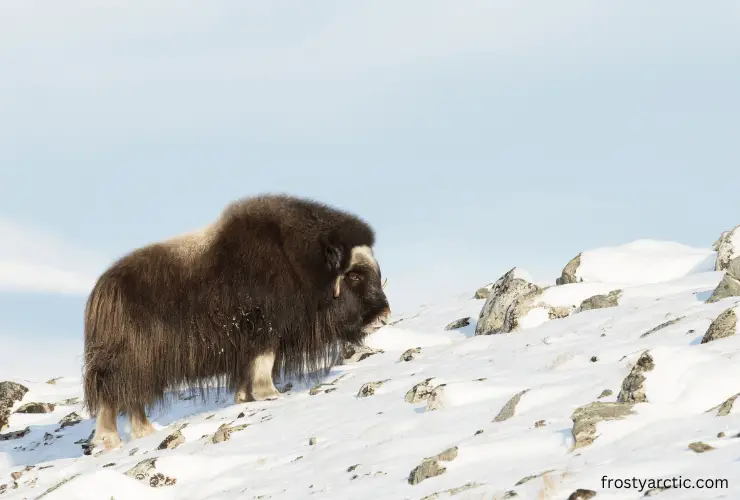

2 thoughts on “Where Do Musk Oxen Live?”